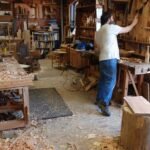Coffee and Wood Shavings: A Journey with Used Tools
It’s early morning, the kind where the sun just barely peeks over the trees, and the world is still waking up. I’ve got my trusty old mug of coffee, the one with the chipped edge from that time my kid thought it’d be fun to play catch with his snack, and I’m staring out at my garage that’s turned into a workshop over the years. You know, everyone always says a man’s garage is his kingdom, but some days it feels more like a realm of chaotic creativity.
A few weeks back, I found myself on a mission. My mother had this old hickory dining table that she swore had been in our family since before the dinosaurs, and it was finally showing its age. One leg was wobblier than my uncle after two too many at the county fair, and I figured it was high time to do something about it.
The Hunt for Tools
Now, let me tell you, I’m no fancy carpenter. I don’t have the shiny, top-of-the-line tools that you see in those glossed-up Youtube videos. Nope, I’m all about finding used tools in the back corners of garage sales or the local flea market. One rainy Saturday, I stumbled across a table saw from an old guy named Earl. Earl was a character, let me tell you. He had more stories than tools, but that saw? It was a Craftsman, a solid piece from the eighties, a little rusty but it hummed like a dream once I plugged it in.
Got home, and the first thing I did was inhale—yea, that smell of oiled metal. It’s like the aroma of potential. I swear, you could bottle that smell and sell it as “Inspiration.” Anyway, I pulled it out and set it in my garage with a bit of pride. Now, I figured I’d need some clamps too, you know, for holding things together while you wrestle with whatever you’re trying to create. So, I dug around and found this old set my dad had when I was a kid, the kind that feels a bit too much like a bear trap when you squeeze it. The paint was chipped, and the rubber handles were cracked, but they still got the job done.
The Project Begins
So there I was, a fresh cup of coffee in hand, ready to restore this family heirloom. I measured, marked, and came up with what I thought was a foolproof plan. The first cut? Smooth as butter. But of course, it went downhill from there. I was feeling all kinds of proud until I realized I didn’t consider the wood grain. I went to make a joint cut, and, well, “snap!”—halfway through, the blade snagged the new piece of oak I was working with, and it all looked like a messy jigsaw puzzle.
I almost gave up then. I mean, who was I kidding? I should have just called a professional. I flipped through a couple of old YouTube videos, all flashy and perfect, and that didn’t help my mood. They made it look so easy. But after a couple of deep breaths, a few muttered curses, and a few minutes of letting the coffee kick in, I decided to soldier on.
The Fix
And get this—after my little mishap, I remembered the stack of reclaimed barn wood I had in one corner of the garage. The stuff was rough around the edges but had this beautiful rustic aesthetic, and the smell of cedar wafting through the air was intoxicating. I got to work blending the new with the old, and before I knew it, I was starting to see something I actually liked. It was like watching the ugly duckling turn into a—not exactly a swan, but hey, let’s call it a duck that’s really trying.
Funny thing, I laughed when it actually worked. I stood back, nursing that same cup of coffee, and for the first time in ages, I felt proud of something I’d actually made with my own two hands. I could almost hear my mother’s voice, “See? It just needed a little love!”
Lessons Learned
But hey, I did learn a few things along the way. For one, patience is key. I mean, if I had rushed through it, it would’ve just ended up in the trash like so many projects before. And using those old tools? It’s kind of a dance. You have to listen to your equipment. Each tool has its personality. That old Craftsman saw? It appreciates a softer touch after all those years.
And let’s not forget about the bond you get with the wood itself. I remember sanding away, and it’s weird how you start talking to the wood, almost like it has a soul. There’s something profound about working with your hands, sharing a moment with something that came from the earth.
The Takeaway
So, if you’re out there thinking about diving headfirst into some DIY project, let me just say: go for it. There’ll be hiccups, trust me. You’ll find yourself staring at half-finished projects and wondering what on earth you were thinking. But don’t let it get you down. Embrace those mistakes. They’re part of the story, part of the journey. And maybe one day, you’ll sit back with a coffee, looking at your creation, and think, “Wow, I really did that.”
And I mean it: if some ol’ blockhead like me can do it, then you sure as heck can too. Just find a rickety old tool, let it inspire you, and start building. You never know what masterpiece—or at least slightly crooked table—you might end up with.









